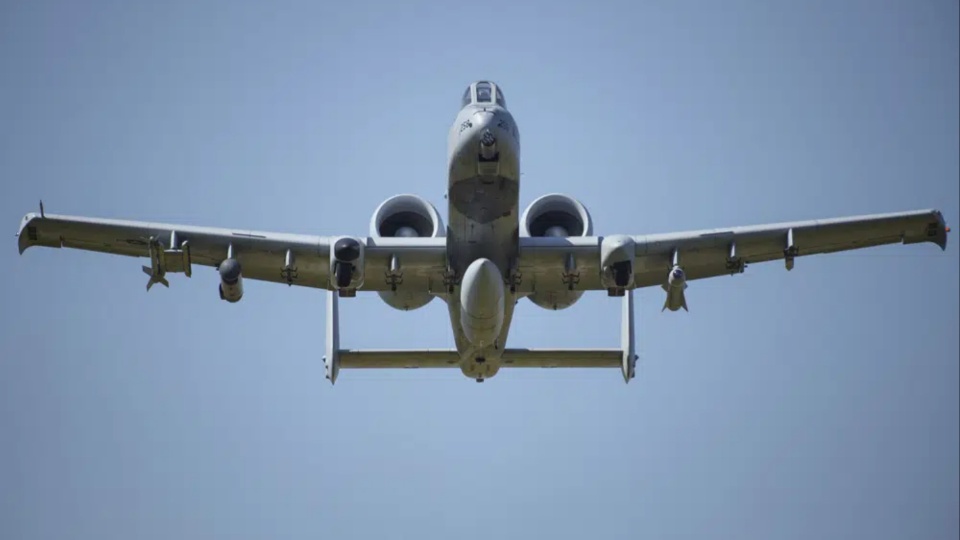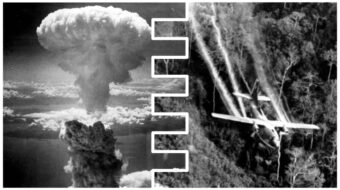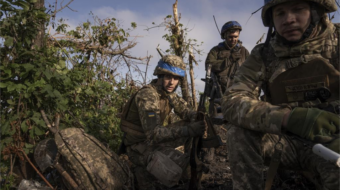
Two weeks ago, the United States and Germany brought the world closer to the brink of all-out world war when they announced they were nearing completion of plans for Air Defender 2023, an air war simulation unprecedented in scale. The massive war games operation launched Monday from air fields in the northern part of Germany.
Just days after their announcement, Russia announced it is placing tactical nuclear weapons in Belarus, a country on its border with which it is allied. The result of the actions by NATO and the reactions by Russia make it more possible than ever that the war in Ukraine could become a catastrophic world war.
During the first years of the Cold War—in the 1940s and early ’50s—the U.S. and the Soviet Union stationed no nuclear weapons outside their own territories. The U.S. ended that situation when it stationed atomic bombs in Britain in 1954, then later deployed medium-range nuclear missiles in West Germany, missiles that could reach Soviet territory in a matter of minutes. Italy, France, Turkey, the Netherlands, Greece, and Belgium would all eventually be added to the list of hosts for U.S. nuclear weapons. Though some weapons were withdrawn after the Cold War, to this day, they remain in Belgium, Germany, Italy, the Netherlands, and Turkey.
The Soviet Union is known to have stationed nuclear weapons, at least for a short time, in East Germany and Cuba, but these were withdrawn and a policy of keeping such weapons within Soviet territory was adhered to for most of the Cold War. Russia continued that policy when the Cold War ended.
At the end of the Cold War, the U.S., the main power behind NATO, pledged that the alliance would not move any further to the east, toward Russia, but it quickly violated that promise. In the years that followed, one country after another was added to NATO ranks, moving the alliance ever-closer to the borders of Russia until eventually nearly the its entire western frontier was made up of adversarial governments armed to the teeth by NATO.
To make matters worse, the U.S. unilaterally canceled the remaining nuclear arms reductions treaties that bound the U.S. and Russia. In addition, war planes capable of delivering nuclear weapons were stationed in many of those countries on or near the borders of Russia, including Poland, Slovakia, Lithuania, Latvia, and Estonia.
After the announcement two weeks ago of the details of NATO’s Air Defender 2023 exercise, Russia announced that it, too, would station nuclear weapons outside its borders—in neighboring Belarus. The weapons are tactical systems that could theoretically be used on battlefields.
The end result is that now, with the launch of Air Defender 2023, the world is far less safe than it was last week. This makes all the more urgent the call by many countries and peace organizations for an immediate ceasefire in Ukraine followed by negotiations.
The U.S., determined to continue what much of the world sees as its proxy war against Russia, is continuing to resist those calls for peace coming from countries like Brazil, South Africa, China, and others on the African continent and in Asia.
The biggest air war provocation in NATO history, Air Defender 2023, involves increased sabre-rattling by the U.S., with Germany at its side. Instead of increased tensions with Russia, we should be aiming for cooperation and trade and working together to solve issues like climate change and other urgent problems faced by the people of the planet.
Instead, we see some 10,000 participants, more than half from the U.S., and 250 aircraft from 25 nations staging simulated attacks that would eventually be aimed at Russia.
“This is an exercise that would be absolutely impressive to anybody who’s watching, and we don’t make anybody watch it,” U.S. Ambassador to Germany Amy Gutmann bragged last week.
Luftwaffe chief Lt. Gen. Ingo Gerhartz told German TV: “The exercise is a signal above all that we are in a position to react very quickly…that we would be able to defend the [NATO] alliance in case of attack.”
He actually spilled the beans by saying that the operation was about “more than just deterrence” and aims to expose young American servicemen to what it would be like to work side by side with Europeans battling a major power. The implication was that what Americans have done so far is carry out warfare against small countries and that this will give them practice working on the “real” thing.
He gave short shrift to the concerns of the German air traffic controllers’ union, GdF. The unionized controllers and pilots on Europe’s airlines have expressed fears about the war games endangering civilians and civilian air flights over Europe. Worries about the lives and safety of civilians were the last thing the Luftwaffe had in mind, however. “I hope that there we will be no cancellations; there may be delays in the order of minutes here and there,” Gerhartz said.
NATO actually intends, after it grabs up every European country, to extend its dominance over the entire world. With this long-range goal in mind, the alliance invited Japan to join the war games. The old “Empire of the Rising Sun” is a “guest” at Air Defender 2023.
The war preparations are not limited to Europe, of course. In the Pacific, the U.S. is planning a multinational naval drill to show China who is boss in that region. Countries participating in the provocation in the Pacific will include the U.S., of course, backed up by France, Japan, Canada, and the Philippines. The Pacific provocation is scheduled for this Friday.
The need for a powerful multi-national peace offensive has never been greater. Keep posted to these pages for plans for a major peace offensive unfolding here in the United States.
As with all op-eds published by People’s World, this article expresses the opinions of its author.
We hope you appreciated this article. At People’s World, we believe news and information should be free and accessible to all, but we need your help. Our journalism is free of corporate influence and paywalls because we are totally reader-supported. Only you, our readers and supporters, make this possible. If you enjoy reading People’s World and the stories we bring you, please support our work by donating or becoming a monthly sustainer today. Thank you!










